It’s winter in Maryland. In fact, it’s so much winter I shoveled 10 inches of snow off my driveway this morning. Fortunately, I had company. It wasn’t the kind of company that picks up a shovel and helps out, but still, the American robins darting back and forth over my head were still welcome (if surprising and surprisingly quiet) snow day companions.
Become a Member
Make a lasting impact for nature when you join The Nature Conservancy
“You know,” I said to them as I leaned on my shovel to watch about 25 birds flock together in my neighbor’s oak. “I think y’all are a little early—aren’t you supposed to be the first harbingers of spring?”
We’re not even a month past the first day of winter in the northern hemisphere. Spring is definitely not here. So why are the robins? Shouldn’t they be sunning themselves in warmer climes?
The short answer: as long as there’s food, American robins—true to their name Turdus migratorius (“the wandering thrush”)—kind of spend their winters coming and going as they please.
Robin Migration (AKA Robin Wandering)
Robins do migrate—but they don’t necessarily follow a more or less straight line from north to south in the fall, then repeat the journey south to north in the spring. In the fall and winter, when the ground freezes, robins lose access to their meal of choice: worms, insects (adult and larval) and (occasionally) snails. That’s when they turn to their winter diet staple: mostly fruit, mostly berries.
The folks at Journey North, a project tracking robin movements run by the University of Wisconsin-Madison, put it this way, “Some robins retreat all the way to southern Texas and Florida (in fact, some of the largest winter flocks documented by the Christmas Bird Count gather in sunny St. Petersburg, Florida), but others winter as far north as they can find berries. So they have an enormous winter range. Robins do migrate, but it has more to do with food sources than with being faithful to the same places year over year.”
In that way American robins are somewhat akin to teenage boys—they tend to go where the best (or most abundant or most easily accessible) food is, stay until it’s depleted, and then move on.
So as long as there are enough berries and other fruits to sustain them, you may see robins off and on throughout the winter across much of North America.
Forget the birdseed though. Robins’ digestive systems, unlike sparrows or other so-called feeder birds, aren’t built for dealing with seed, and their beaks aren’t built for cracking things open. Robin beaks are built for snapping up worms, catching insects, and plucking berries and other fruits. In the winter, a flock of robins can strip a holly bush with impressive speed and efficiency, and very little—if any—violent robin-on-robin aggression.
Food is also one of the reasons that robins, notoriously territorial and aggressive in breeding season, tend to gather and travel in flocks in the fall and winter. Numbers are good for defense, and also for spotting food—if one robin happens on a holly tree full of bright, ripe berries, the whole flock can partake. And then move on.
The tendency of robins to flock in winter may also be one of the reasons people seem to notice them—birds in large numbers tend to stand out when they’re gathered in leafless trees. (That and the beautiful red breast that is sometimes the only splash of color in a winter landscape that looks practically lunar in relentless shades of February white and gray.)
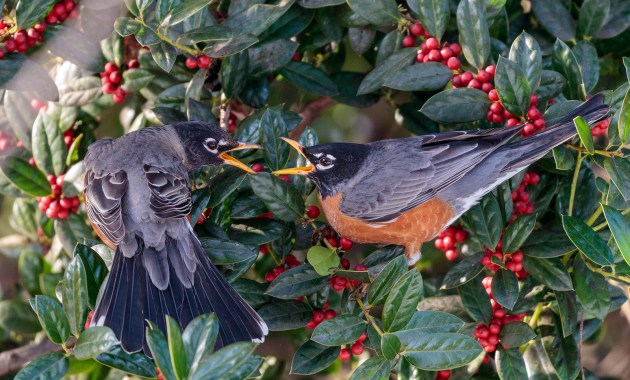
How do Robins Survive the Cold?
Robins are outfitted to survive huge temperature variances. In fact, hot weather seems to stress them more than cold.
If an American robin is healthy, has enough to eat, and is able to main its feathers, the temperature next to its body stays around 104 F—regardless of how cold it is in the world outside. It really is all about those feathers. (And the legs and feet.)
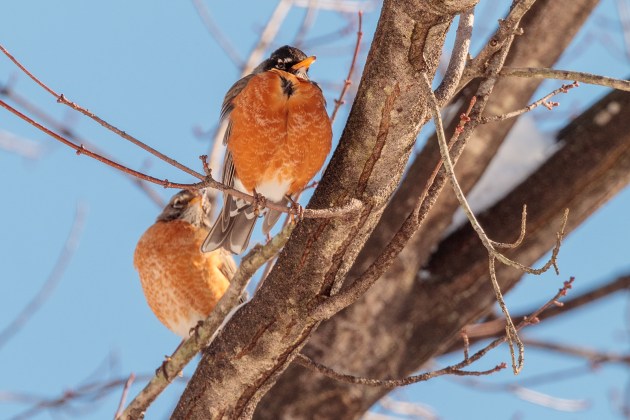
Robins, like most birds, have layers of feathers that perform different functions. When temperatures drop, robins puff the fine, downy feathers closest to their bodies to keep heat in, cold out. The outer feathers act like a kind of overcoat, shedding water and moisture and helping to regulate the bird’s temperature. (It’s an adaptation not limited to robins. Most birds with down feathers fluff them to regulate body heat).
The anatomy of a robin’s (and other bird species) also contributes to their cold adaptations. The bird experts over at the Cornell Lab explain it very well. The simplified version is that “most birds don’t succumb to frostbite because there is so little fluid in the cells of their feet, and their feet are mostly tendons and bones with little muscle or nerve tissue.”
So while blood does flow to their legs and feet, most birds (including robins) benefit from a very fast circulatory system and a “countercurrent heat exchange system.” Because bird legs are thin, the vessels that move blood from the heart to the feet and back again are very close together. That proximity means, per Cornell, “blood flowing back to the body is warmed by blood flowing to the feet. The newly cooled blood in the feet lowers heat loss from the feet, and the warmed blood flowing back into the body prevents the bird from becoming chilled.”
Robins: The Tell-Tale Birds of Spring
If robins are around in winter, why have they always been associated with the beginning of spring in the U.S.? Most likely it has to do with ground thaw, snow melt, and territorial behaviors like singing, worm hunting and nest building. But mostly, it’s the singing.
According to Journey North, which has a fantastic Q+A section I highly recommend for the robin-curious, “the robin’s song remains a reliable indicator that the first wave of spring migration has reached you. This song is one of the first signs that robins are switching from winter behavior to courtship and nesting behaviors associated with spring.”
Robins tend to move north as the ground thaws. The availability of high protein prey, especially worms that emerge with warmer, often wetter weather, is when a robin’s thoughts turn to procreation. And that’s the end of the cooperative fall and winter behaviors.
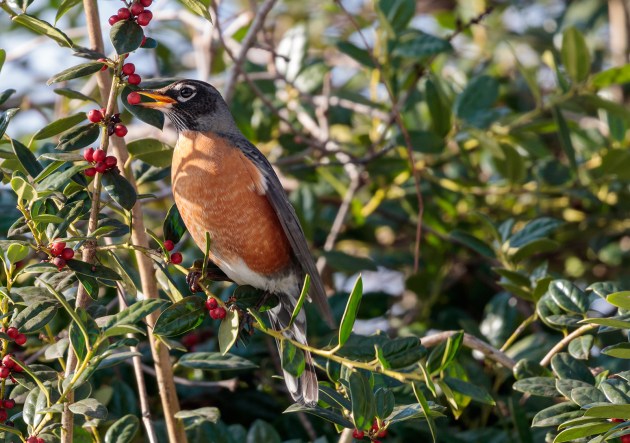
Which is one of the reasons many robins (primarily males) may stay through harsher winters instead of booking it to St. Petersburg: first access to the choicest nesting grounds. Breeding season is when robins also become more visible with mating displays, nest-building and a lot of time on the ground hunting for the tastiest worms. Until then, they’re all about the berries.
You Can Help Robins with Science from Your Own Backyard
Like many species, including other birds, scientists are starting to see some changes in robin behavior that is likely attributable to climate change. One study of American robins migrating to and from Canada’s boreal forest, showed that they’re beginning to journey south on average about 12 days earlier than in past years, or five days earlier per decade since 1994.
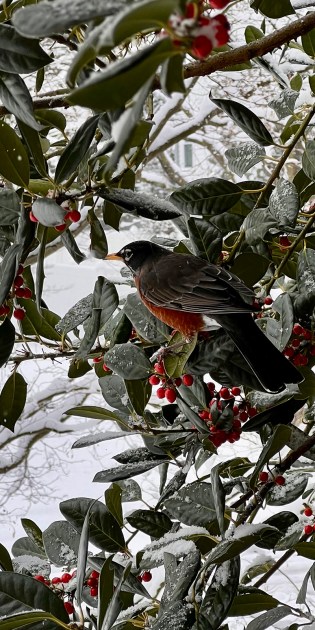
If you want to help scientists studying birds, there are several ways to contribute your observations (not just for robins, but for many of the species you can see outside your windows).
Journey North
You can submit your robin observations directly on the Journey North site (and check out their other migration-related citizen science projects). They also have 2025 maps tracking sightings so you can see where American robins (and other signs of spring) are being observed and follow along (and contribute to) the wanderings of Turdus migratorius.
Cornell Lab of Ornithology
The Cornell Lab has a number of different ways you can contribute to science for birds. Your sightings tracked on eBird (free) contribute to worldwide data for birding, science, and conservation. Want to know what birds are being seen in your neighborhood, eBird has a feature for that. If you’re new to birding, check out their genius birding ID app, Merlin.
You can also contribute to Project FeederWatch (requires subscription) by counting birds at your feeder from November through April. Your observations help scientists monitor changes in the abundance and distribution of birds, including the influence of changes in habitat, disease, and climate.
And mark your calendars for the 2025 Great Backyard Bird Count (February 14-17). Spend time in your favorite places watching birds—then report them to Cornell! It’s easy to participate, “in as little as 15 minutes notice the birds around you. Identify them, count them, and submit your counts to help scientists better understand and protect birds around the world. You can see the results from 2024 here.
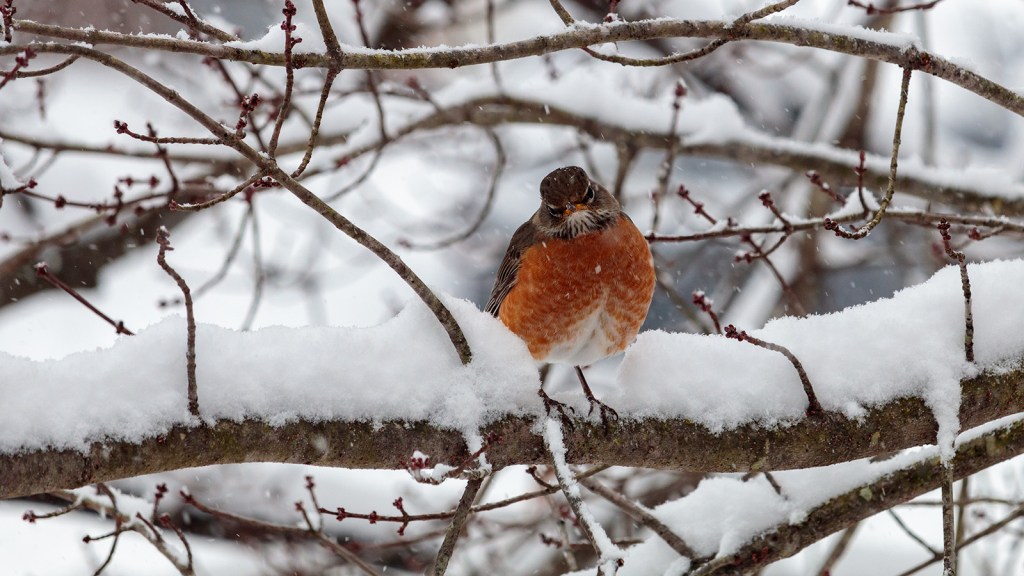



With the big ice and snow storm in Texas this week, we’ve had a multiple instances of robins feeding!
On Tuesday February 16, 2021 we had about 50 or more of these Robins in our yard on or trees and found our Bushes full of berries and they were swarming them in front and ate every last one. Many of them in the ground and in trees and sitting on our back fence. Where the snow had melted some were pecking the ground in search of other food and some just eating the snow off our sidewalk in back. We took several photos of them as we watched.
Renee’ James-Gilbert
Fort Worth, Texas 76118
We’ve just experienced unusually cold weather (as low as -1* ) just North of Dallas in Allen, Texas and for a couple of days had hundreds of Robins in a wooded area by our home. Have never seen them so early and in this weather,…your article addressed that…thank you!
I live in Arlington TX and I have seen flocking red breast in my holly bushes. It was such a beautiful site. They have just about eaten all the red fruit berries off the bushes. GOD MAKES ALL THINGS BEAUTIFUL .
Last week there were probably 30-50 robins in my yard, I saw them a few days but haven’t seen any this week. I live on Cape Cod, MA. My daughter told me today she saw a bunch in her yard today, she lives in RI. I do see Cardinals all the time.
I’m in central Texas , Smithville to be exact. The date is February the 19th and fir the last two weeks I’ve been seeing Robin’s for the first time in 30 plus years. At first I wasn’t sure, then it was more the one at a time. Today I’m 12 miles in Bastrop, Texas and we’ve been seeing Robin’s around here as well. For the longest time I’ve been under the impression that the fire ants killed the all off. They are indeed here and it’s extremely nice to see them again.
I have lived in Forney, TX for going on 15 years and for the first time we have had huge numbers of robins in our trees, along our fences and in both our front and back yards. They are all over our neighborhood in great numbers. It was surprising because we just had an unprecedented long period of temperatures below freezing and more snow lasting longer than just a day or two. It was nice to see the birds and I am glad to know they can survive these weather conditions. Thank you for the information on these beautiful birds.
I feed insectivores in my backyard year round. Right now, with the arctic blast encompassing the southwest, my offering of live mealworms are the difference between survival or not. (Writing this on the 10th day of sub freezing temps 24/7 in Tulsa, OK) I observed the arrival of a robin shortly into the 10 day freeze. That robin was dominant, of course, and would back off when other birds arrived. In fact all of the birds, regardless of species, would eat and then head to the edge of my yard where I have oaks and deep thick bushes. But for about 7 days now, and increasingly, the robin will just camp out on or next to the warming plate of mealworms. He will literally attack bluebirds brave enough to try to fly down and grab a bite. He fends off the phoebes, but doesn’t fly after them or the wrens like he does the blues. And now? A second robin has arrived. I must admit to shooing them off, or even using my home fashioned/not very well working pea shooter at them. I don’t want them to starve, I only want them to back off and allow the others a bite of food. The behavior is very distressing to me.
I observed a flock of robins that came into our yard during our really cold weather here in north TX. Swarmed around some our holly bushes. Never seen robins in mass, and really can’t recall seeing any during the rest of the year. I’m sure they are here, but I don’t see them. Is there a particular way to draw robins in yard? We have not put out any bird food in years. We have feral cats that live in our yar d (I captured and neutered them, so they stayed) and felt when we put our food that we were luring birds to their death. Our last cat is aging now, and we will once again feed the birds. Love to see robins and cardinals. Those were the most common birds of my childhood and my grandmother’s favorite. So, they are special to me. Thanks for posting this piece. Brought me joy this morning.
I live in Kittery, Maine and for the first time ever have a flock of Robins in my yard, most likely due to the unfrozen water I have provided this year. This piece has answered all the questions I had when I first saw them since I only ever see solitary Robins, so thank you for writing it. It was a sight to behold, twelve Robins in and on the edges of my bird bath and countless others in the bushes around it and on the ground, waiting for their turn. Just beautiful.
Yesterday a large flock of robins (about 25 or more) swarmed my heated bird bath in mid-Michigan. This with 14” of snow from the previous day. They stayed for about an hour.
Yes we live in Benton Arkansas and just noticed a very large amount of Robins flying around late in the afternoon next door to a friend that lives on my street. I mean there were tons of them! We were surprised and also enjoyed the show they put on !
This past freezing week (Feb 15- Feb. 19, 2021) I have had a flock of Robins all over my back yard in Tulsa, OK. I’ve counted at least 30, but there may have been more. They’ve been eating the holly berries and seem to be digging around in the garden next to my house. They have made a huge mess of leaves and their droppings on my back patio, but have been fun to watch.
Hundreds of robins reported all across Arlington, Texas. Many, many Facebook posts. I saw them out our window tues feb 16, flying east, in trees, wave after wave in the air. Then yesterday Wednesday same phenomenon but they were flying west . We’ve been in the middle of extreme cold and snow.
Robins are here in Southeast Texas! They don’t mind the snow and freezing temps this week!